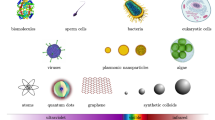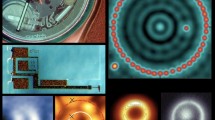Abstract
In this paper, we investigate the quantum force sensing in a single optomechanical system by the use of a coherent quantum noise cancellation scheme. The system consists of a Fabry–Pérot cavity simultaneously coupled to a mechanical oscillator and an ensemble of atom. Accordingly, the dynamics of the systems are studied by utilizing the quantum Langevin equations approach. It is found that the backaction noise can be eliminated from coherent quantum noise cancellation. Remarkably, we examine a force sensor that uses coherent noise cancellation to beat the standard quantum limit. We also investigate the effect of coherent transitions to atomic noise suppresses, and these simultaneous processes can significantly enhance the performance of the quantum force sensor. Our scheme can be generalized to other hybrid optomechanical systems, and these results may have spectacular applications for the realization of the quantum force sensor.






Similar content being viewed by others
References
A.A. Clerk, M.H. Devoret, S.M. Girvin, F. Marquardt, R.J. Schoelkopf, Introduction to quantum noise, measurement and amplification. Rev. Mod. Phys. 82, 1155 (2010)
S. Ghosh, D. Carney, P. Shawhan, J.M. Taylor, Backaction-evading impulse measurement with mechanical quantum sensors. Phys. Rev. A 102, 023525 (2020)
C.M. Caves, Quantum-mechanical noise in an interferometer. Phys. Rev. D 23, 1693 (1981)
M.T. Jaekel, S. Reynaud, Quantum limits in interferometric measurements. Euro. Phys. Lett. 13, 301 (1990)
M. Tsang, C.M. Caves, Coherent quantum-noise cancellation for optomechanical sensors. Phys. Rev. Lett 105, 123601 (2010)
C. Fabre, M. Pinard, S. Bourzeix, A. Heidmann, E. Giacobino, S. Reynaud, Quantum-noise reduction using a cavity with a movable mirror. Phys. Rev. A 49, 1337 (1994)
M.H. Wimmer, D. Hammerer, K. Heurs, M. Coherent, Cancellation of backaction noise in optomechanical force measurements. Phys. Rev. A 89, 053836 (2014)
T. Caniard, P. Verlot, T. Briant, P.F. Cohadon, A. Heidmannm, Observation of back-action noise cancellation in interferometric and weak force measurements. Phys. Rev. Lett. 99, 110801 (2007)
T. Gebremariam, Y.X. Zeng, M. Mazaheri, C. Li, Enhancing optomechanical force sensing via precooling and quantum noise cancellation. Sci. China-Phys. Mech. Astron. 63, 210311 (2020)
S. Schreppler, N. Spethmann, N. Brahms, T. Botter, M. Barrios, D.M. Stamper-Kurn, Optically measuring force near the standard quantum limit. Science 344, 1486 (2014)
M. Aspelmeyer, T.J. Kippenberg, F. Marquardt, Cavity optomechanics. Rev. Mod. Phys. 86, 1391 (2014)
T. Gebremariam, Generation of the bipartite entanglement and correlations in an optomechanical array. J. Opt. Soc. Am. B 37, A245–A252 (2020)
A. Motazedifard, F. Bemani, M.H. Naderi, R. Roknizadeh, D. Vitali, Force sensing based on coherent quantum noise cancellation in a hybrid optomechanical cavity with squeezed-vacuum injection. New. J. Phys. 18, 073040 (2016)
P.H. Kim, B.D. Hauer, C. Doolin, F. Souris, J.P. Davis, Approaching the standard quantum limit of mechanical torque sensing. Nat. Commun. 7, 1 (2016)
W.P. Bowen, G.J. Milburn, Quantum optomechanics. Physics 86, 1391 (2015)
F. Marjan, A. Dalafi, Back-action evading measurement of the collective mode of a Bose–Einstein condensate. J. Opt. Soc. Am. B 37, 1263 (2020)
W. Zhao, S.D. Zhang, A. Miranowicz, H. Jing, Weak-force sensing with squeezed optomechanics. Sci. China-Phys. Mech. Astron. 63, 224211 (2020)
R.G. Knobel, A.N. Cleland, Nanometre-scale displacement sensing using a single electron transistor. Nature 424, 291 (2003)
S. Forstner, J. Knittel, E. Sheridan, J.D. Swaim, H. Rubinsztein-Dunlop, W.P. Bowen, Sensitivity and performance of cavity optomechanical field sensors. Photon. Sens. 2, 259 (2012)
J. Harms, Y. Chen, S. Chelkowski, A. Franzen, H. Vahlbruch, K. Danzmann, R. Schnabel, Squeezed-input, optical-spring, signal-recycled gravitational-wave detectors. Phys. Rev. D 68, 042001 (2003)
F. Bariani, H. Seok, S. Singh, M. Vengalattore, P. Meystre, Atom based coherent quantum noise cancellation in optomechanics. Phys. Rev. A 92, 043817 (2015)
S. Aldana, C. Bruder, A. Nunnenkamp, Equivalence between an optomechanical system and a Kerr medium. Phys. Rev. A 88, 043826 (2013)
J.B. Brask, R. Chaves, J. Kolodynski, Improved quantum magnetometry beyond the standard quantum limit. Phys. Rev. X 5, 031010 (2015)
R. Schnabel, N. Mavalvala, D.E. Mc.Clelland, P.K. Lam, Quantum metrology for gravitational wave astronomy. Nat. Commun. 1, 1 (2010)
K. Zhang, P. Meystre, W. Zhang, Back-action-free quantum optomechanics with negative mass Bose–Einstein condensates. Phys. Rev. A 88, 043632 (2013)
F.Y. Khalili, E.S. Polzik, Overcoming the standard quantum limit in gravitational wave detectors using spin systems with a negative effective mass. Phys. Rev. Lett. 121, 031101 (2018)
A. Cleland, Photons refrigerating phonons. Nat. Phys. 5, 458 (2009)
J.D. Thompson, B.M. Zwickl, A.M. Jayich, F. Marquardt, S.M. Girvin, J.G. Harris, Strong dispersive coupling of a high-finesse cavity to a micromechanical membrane. Nature 452, 72 (2008)
B. Xiong, X. Li, X.Y. Wang, L. Zhou, Improve microwave quantum illumination via optical parametric amplifier. Ann. Phys. 385, 757 (2017)
A.V. Taichenachev, A.M. Tumaikin, V.I. Yudin, L. Hollberg, Two-dimensional sideband Raman cooling and Zeeman-state preparation in an optical lattice. Phys. Rev. A 63, 033402 (2001)
J.J. Hopfield, Theory of the contribution of excitons to the complex dielectric constant of crystals. Phys. Rev. 112, 1555 (1958)
S. Gröblacher, K. Hammerer, M.R. Vanner, M. Aspelmeyer, Observation of strong coupling between a micromechanical resonator and an optical cavity field. Nature 460, 724 (2009)
Z. Yang, S.L. Chao, L. Zhou, Generating macroscopic quantum superposition and a phonon laser in a hybrid optomechanical system. J. Opt. Soc. Am. B 37, 1 (2020)
B. Xiong, X. Li, S.L. Chao, Z. Yang, W.Z. Zhang, W. Zhang, L. Zhou, Strong mechanical squeezing in an optomechanical system based on Lyapunov control. Photon. Res. 8, 151 (2020)
V.E. Tarasov, Fractional heisenberg equation. Phys. Lett. A 372, 2984 (2008)
M.G. Moore, O. Zobay, P. Meystre, Quantum optics of a Bose Einstein condensate coupled to a quantized light field. Phys. Rev. A 60, 1491 (1999)
Y. Tanimura, P.G. Wolynes, Quantum and classical Fokker–Plank equations for a Gaussian–Markovian noise bath. Phys. Rev. A 43, 4131 (1991)
V. Giovannetti, D. Vitali, Phase-noise measurement in a cavity with a movable mirror undergoing quantum Brownian motion. Phys. Rev. A 63, 023812 (2001)
N.C. Sahoo, B.K. Panigrahi, P.K. Dash, G. Panda, Application of a multivariable feedback linearization scheme for STATCOM control. Electric Power Syst. Res. 62, 81–91 (2002)
E.X. DeJesus, C. Kaufman, Routh–Hurwitz criterion in the examination of eigenvalues of a system of nonlinear ordinary differential equations. Phys. Rev. A 35, 5288 (1987)
X. Yang, Y. Ling, X. Shao, M. Xiao, Generation of robust tripartite entanglement with a single-cavity optomechanical system. Phys. Rev. A 95, 052303 (2017)
M. Abdi, S. Barzanjeh, P. Tombesi, D. Vitali, Phys. Rev. A 84, 032325 (2011)
L. Tian, Z. Li, Nonreciprocal quantum-state conversion between microwave and optical photons. Phys. Rev. A 96, 013808 (2017)
B. Xiong, X. Li, S.L. Chao, Z. Yang, R. Peng, L. Zhou, Strong squeezing of duffing oscillator in a highly dissipative optomechanical cavity system. Annalen der Physik 532, 1900596 (2020)
T. Gebremariam, Y.X. Zeng, X.Y. Chen, C. Li, Observation and measures of robust correlations for continuous variable system. Commun. Theor. Phys. 68, 661 (2017)
A. Motazedifard, A. Alafi, F. Bemani, M.H. Naderi, Force sensing in hybrid Bose–Einstein-condensate optomechanics based on parametric amplification. Phys. Rev. A 100, 023815 (2019)
M. Rossi, D. Mason, J. Chen, Y. Tsaturyan, A. Schliesser, Measurement-based quantum control of mechanical motion. Nature 563, 53 (2018)
J.D. Thompson, B.M. Zwickl, A.M. Jayich, F. Marquardt, S.M. Girvin, J.G.E. Harris, Strong dispersive coupling of a high-finesse cavity to a micromechanical membrane. Nature 452, 72 (2008)
W. Zhao, S.D. Zhang, A. Miranowicz, H. Jing, Weak-force sensing with squeezed optomechanics. Sci. China-Phys. Mech. Astron 63, 224211 (2020)
R. Ghobadi, S. Gholizadeh, M. Mazaheri, Weak force measurement in bistable optomechanical system. Int. J. Opt. Photon. 9, 19 (2015)
A. Pontin, J.E.A. Lang, A. Chowdhury, P. Vezio, B. Marino, T.S. Monterio, Imaging correlations in hetrodyne spectra for quantum displacement sensing. Phys. Rev. Lett. 120, 020503 (2018)
Acknowledgments
We would like to thank Merkebu Dereje and Nuredin Nassir for their help on English editing and grammar.
Funding
This research was supported by the College of Natural Sciences, Department of Physics, Arba Minch University, Arba Minch 21, Ethiopia.
Author information
Authors and Affiliations
Corresponding author
Ethics declarations
Conflict of interest
The authors declare that there are no conflicts of interest related to this paper.
Additional information
Publisher's Note
Springer Nature remains neutral with regard to jurisdictional claims in published maps and institutional affiliations.
Appendices
Appendix
Effective susceptibilities
In this appendix, we express the effective susceptibilities of the cavity field (\(\chi _{a}\)), the membrane (\(\chi _{m}\)), and atomic ensemble (\(\chi _{c}\)) as:
and the modified cavity field susceptibility \(\chi _{a}^{\prime }\) as:
The standard quantum limit
The noise spectrum result of a hybrid system with a standard optomechanical setup
the backaction noise scales directly proportional to the measurement \(g^{2}\) and the shot noise scales inversely proportional to the \(\frac{1}{g^{2}}\). In addition, to realize the lower bound of the standard quantum limit of continuous force sensing, we minimize \(S_{F}^\mathrm{stad}\) noise spectrum with respect to \(g^{2}\) and \(T \ne 0\),
In view of the frequency and damping rate of the membrane resonator leads to the membrane susceptibility which is efficiently amplified in the force noise spectral density can be significantly reduced which improves the force sensitivity in CQNC condition.
Rights and permissions
About this article
Cite this article
Tesfahannes, T.G., Tsanger, M.M. Quantum force sensing using backaction noise suppression in optomechanical system. J Opt 50, 35–45 (2021). https://doi.org/10.1007/s12596-020-00654-y
Received:
Accepted:
Published:
Issue Date:
DOI: https://doi.org/10.1007/s12596-020-00654-y




